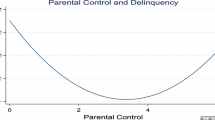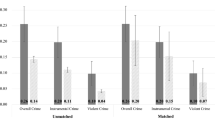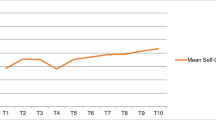Abstract
Objective
This work further examines the functional form of the self-control–delinquency relationship as an extension of recent work by Mears et al. (J Quant Criminol, 2013). Given the importance of the authors’ conclusions regarding the nonlinear relationship between these two variables and the recognition that there are some potential limitations in the sample and assumptions required for the analytic methods used, we apply both similar and alternative techniques with a data set comprised of serious youthful offenders to determine whether key findings can be replicated.
Methods
Data from the Pathways to Desistance study, which comprise extensive individual and social history interviews with 1,354 offenders over multiple waves spread out over 84 months, is utilized in this analysis. These data are well-suited to investigating the questions of interest as the target population comprises youth with offending histories that are more extensive than those likely to be found in general surveys of adolescents. The analyses consider the self-control–delinquency relationship in an alternative sample with the previously used Generalized Propensity Score (GPS) procedure, which requires strong assumptions, as well as nonparametric regression which requires far weaker assumptions to consider the functional form of the self-control–delinquency relationship.
Results
The results generally show that the identified functional form of the self-control–delinquency relationship seems to be at least partly dependent on aspects of the modeling of dose–response associated with GPS procedures. When nonparametric general additive models are used with the same data, the relationship between self-control and delinquency seems to be approximately linear.
Conclusions
Identifying functional form relationships has importance for many criminological theories, but it is a task that requires that the balance of model assumptions to exploratory data analysis falls toward the latter. Nonparametric approaches to such questions may be a necessary first step in learning about the nature of mechanisms presumed to be at work in important explanations for crime and criminality.








Similar content being viewed by others
Notes
To be clear, it is likely that the ADD Health data have generalizability over the larger range of the self-control continuum, yet to more precisely identify a lower threshold, one would be interested in a very restricted range of this continuum, which would presumably be well-populated in an offender sample.
An identification problem occurs when reasonable inferences cannot be drawn even when the researcher has access to very large (or infinite) sample sizes. This is in contrast to questions of statistical inference, which aim to draw weaker conclusions from finite samples.
Some prior research has identified important distinctions in the self-control-delinquency relationship in offender samples as opposed to youth from general population samples suggesting a need to consider generalizability in the measurement and observed effects across subpopulations in a substantive sense (see, e.g., DeLisi et al. 2003).
This is an extension of the analysis Mears and colleagues' describe where they removed 5 % of cases at either end of the distribution, which identified a similar trend to their Fig. 2. While it is somewhat unexpected, it is intuitive that a near-identical trend would still be seen when a relatively small proportion of cases is removed at either end of the distribution. However, reaching that same conclusion when restricting the analysis to the portion of the data that displayed a linear trend previously is counterintuitive as the process should not produce a similar trend if we are capturing an unfiltered picture of the relationship between self-control and delinquency without boundary bias.
This sensitivity analysis approach in some sense parallels the approach taken by Kluve et al. (2012) in the “Robustness” section of their paper as far as considering the impact of removing certain covariates representing second-order moments from the dose–response model.
Ostensibly, the use of more terms in the parametric specification would seem to imply greater flexibility and fewer assumptions (since the high degree of parameterization would presumably allow flexible results). Yet we seem to be observing the opposite, namely that the results are sensitive to the parameterization assumptions.
Information regarding the rationale and overall design of the study can be found in Mulvey et al. (2004), while details regarding recruitment, a description of the full sample, and the study methodology are discussed in Schubert et al. (2004). All data used in this analysis are publicly available through Mulvey (2012) and our syntax is available upon request.
Although there are limitations in dichotomizing key variables (MacCallum et al. 2002), the Mears et al. work was based on limited dependent variables (a truncated count and a dichotomy) so that approach was utilized here to ensure as much comparability as possible.
For more detailed information on measures and constructs, interested individuals are encouraged to visit the study website (http://www.pathwaysstudy.pitt.edu).
This parallels Berk’s (2004) suggested best practices for using multiple regression as a tool for description and learning about relationships as opposed to a method for causal inference.
GAM generalizes the linear model by modeling E[Y|X] = s 0 + s 1(X), where s 1(·) is any smooth function, here estimated using smoothing splines.
Balance is evaluated at three cut points in the GPS process such that the propensity score, comprising the potential treatment values, is segmented into intervals and then the median of the GPS for each of those groups is evaluated relative to the others in terms of the differences in covariate values for those that fall into the focal treatment interval and those that are assigned to that interval by virtue of their propensity score but actually belong to a different treatment interval (Bia and Mattei 2008; Hirano and Imbens 2004). Other authors stress the importance of assessing whether common support conditions are met in the context of GPS (Flores et al. 2012; Kluve et al. 2012) and recent work has attempted to integrate those tests into the Stata program as well (Bia et al. 2013).
Two technical notes on estimation bear mentioning. First, since the outcome is dichotomized, we use a standard logit link function in the estimator. Second, a typical concern with many nonparametric estimators is over-fitting or under-fitting the model, either of which may obscure results. We address this issue by using cross-validation to ensure optimal fit in the R package, Mixed GAM Computation Vehicle with GCV/AIC/REML smoothness estimation and GAMs by REML/PQL (MGCV), developed by Wood (2006).
In an effort to estimate GAM models that were similar to the parametric specification utilized in GPS, we did also analyze variants of the nonviolent and violent delinquency models that included an interaction term. That variable was treated parametrically in GAM due to the fact that it is a nonadditive term (see Fox 2008). The patterns in those plots were similar to those shown in Figs. 5, 6 and 7, except that there is a slight inflection for the upper range of self-control for nonviolent offending. That pattern becomes nearly linear when the interaction term is removed from the model (as shown in Fig. 7).
References
Agnew R (2005) Why do criminals offend? A general theory of crime and delinquency. Roxbury, Los Angeles
Berk R (2004) Regression analysis: a constructive critique. Sage, Thousand Oaks
Bia M, Mattei A (2008) A Stata package for the estimation of the dose–response function through adjustment for the generalized propensity score. Stata J 8:354–373
Bia M, Flores-Lagunes A, Mattei A (2013) A Stata package for the application of semiparametric estimators of dose–response functions. CEPS/INSTEAD working paper. http://ideas.repec.org/p/irs/cepswp/2013-07.html
Caliendo M, Kopeinig A (2008) Some practical guidance for the implementation of propensity score matching. J Econ Surv 22:31–72
Cleveland W (1979) Robust locally weighted regression and smoothing scatterplots. J Am Stat Assoc 74:829–836
Cook RD, Weisberg S (1999) Applied regression including computing and graphics. Wiley, New York
DeLisi M, Hochstetler A, Murphy D (2003) Self-control behind bars: a validation study of the Grasmick et al. scale. Justice Q 20:241–263
Feldman SS, Weinberger DA (1994) Self-restraint as a mediator of family influences on boys’ delinquent behavior: a longitudinal study. Child Dev 65:195–211
Finifter BM (1975) Replication and extension of social research through secondary analysis. Soc Sci Inf 14:119–153
Flores CA, Flores-Lagunes A, Gonzalez A, Neumann TC (2012) Estimating the effects of length of exposure to instruction in a training program: the case of job corps. Rev Econ Stat 4:153–171
Fox J (2000a) Nonparametric simple regression: smoothing scatterplots. Sage, Thousand Oaks
Fox J (2000b) Multiple and generalized nonparametric regression. Sage, Thousand Oaks
Fox J (2008) Applied regression analysis and generalized linear models. Sage, Thousand Oaks
Goode E (2008) Out of control: an introduction to the general theory of crime. In: Goode E (ed) Out of control: assessing the general theory of crime. Stanford University Press, Palo Alto, pp 1–25
Gottfredson MR (2006) The empirical status of control theory in criminology. In: Cullen FT, Wright JP, Blevins KR (eds) Taking stock: the status of criminological theory—advances in criminological theory, vol 15. Transaction, New Brunswick, pp 77–100
Gottfredson M, Hirschi T (1990) A general theory of crime. Stanford University Press, Palo Alto
Grasmick HG, Tittle CR, Bursik RJ, Arneklev BJ (1993) Testing the core empirical implications of Gottfredson and Hirschi’s general theory of crime. J Res Crime Delinq 30:5–29
Guo S, Fraser MW (2010) Propensity score analysis: statistical methods and applications. Sage, Thousand Oaks, CA
Hastie TJ, Tibshirani RJ (1990) Generalized additive models. Chapman & Hall/CRC, Boca Raton
Hay C, Forrest W (2008) Self-control theory and the concept of opportunity: the case for a more systematic union. Criminology 46:1039–1072
Hedström P (2005) Dissecting the social: on the principles of analytic sociology. Cambridge University Press, New York
Hirano K, Imbens GW (2004) The propensity score with continuous treatments. In: Gelman A, Meng XL (eds) Applied Bayesian modeling and causal inference from incomplete data perspectives. Wiley, West Sussex, pp 77–84
Hirschi T, Gottfredson MR (1993) Commentary: testing the general theory of crime. J Res Crime Delinq 30:47–54
Hirschi T, Gottfredson MR (2008) Critiquing the critics: the authors respond. In: Goode E (ed) Out of control: assessing the general theory of crime. Stanford University Press, Palo Alto, pp 217–231
Imai K, van Dyke D (2004) Causal inference with generaltreatment regimes: generalizing the propensity score. J Am Stat Assoc 99:854–866
Imbens GW, Rubin DB, Sacerdote BI (2001) Estimating the effect of unearned income on labor earnings, savings, and consumption: evidence from a survey of lottery players. Am Econ Rev 91:778–794
Kluve J, Schneider H, Uhlendorff A, Zhao Z (2012) Evaluating continuous training programmes by using the generalized propensity score. J R Stat Soc A 175:587–617
Knight GP, Little M, Losoya SH, Mulvey EP (2004) The self-report of offending among serious juvenile offenders cross-gender, cross-ethnic/race measurement equivalence. Youth Violence Juv Justice 2:273–295
Kochanska G, Knaack A (2003) Effortful control as a personality characteristic of young children: antecedents, correlates, and consequences. J Pers 71:1087–1112
Kuhn TS (1970) The structure of scientific revolutions. University of Chicago Press, Chicago
Lieberson S (1985) Making it count: the improvement of social research and theory. University of California Press, Berkeley
MacCallum RC, Zhang S, Preacher KJ, Rucker DD (2002) On the practice of dichotomization of quantitative variables. Psychol Methods 7:19–40
Manski CF (2003) Identification problems in the social sciences and everyday life. South Econ J 70:11–21
Manski CF (2007) Identification for prediction and decision. Harvard University Press, Cambridge
Mears D, Cochran J, Beaver K (2013) Self-control theory and nonlinear effects on offending. J Quant Criminol 29:447–476
Mulvey EP (2012) Research on Pathways to Desistance [Maricopa County, AZ and Philadelphia County, PA]: subject measures, 2000–2010. ICPSR29961-v1. Inter-university consortium for political and social research [distributor], Ann Arbor, MI, 20 Aug 2012. doi:10.3886/ICPSR29961.v1
Mulvey EP, Steinberg L, Fagan J, Cauffman E, Piquero AR, Chassin L (2004) Theory and research on desistance from antisocial activity among serious adolescent offenders. Youth Violence Juv Justice 2:213–236
Mulvey EP, Steinberg L, Piquero AR, Besana M, Fagan J, Schubert C, Cauffman E (2010) Trajectories of desistance and continuity in antisocial behavior following court adjudication among serious adolescent offenders. Dev Psychopathol 22:453–475
Osgood D, Schreck C (2007) A new method for studying the extent, stability, and predictors of individual, specialization in violence. Criminology 45:273–312
Ousey GC, Wilcox P (2007) The interaction of antisocial propensity and life-course varying predictors of delinquent behavior: differences by method of estimation and implications for theory. Criminology 45:313–354
Piquero A (2008) Measuring self-control. In: Goode E (ed) Out of control: assessing the general theory of crime. Stanford University Press, Palo Alto, pp 26–37
Posner MI, Rothbart MK (2000) Developing mechanisms of self-regulation. Dev Psychopathol 12:427–441
Pratt TC, Cullen FT (2000) The empirical status of Gottfredson and Hirschi’s general theory of crime: a meta-analysis. Criminology 38:931–964
Rosenbaum PR (1984) The consequences of adjustment for a concomitant variable that has been affected by the treatment. J R Stat Soc 147:656–666
Rosenbaum PR (1995) Observational studies. Springer-Verlag, New York
Schubert CA, Mulvey EP, Steinberg L, Cauffman E, Losoya S, Hecker T, Chassin L (2004) Operational lessons from the Pathways to Desistance Project. Youth Violence Juv Justice 2:237–255
Shadish W, Cook T, Campbell D (2002) Experimental and quasi-experimental design for generalized causal inference. Houghton Mifflin, Boston
Weinberger DA, Schwartz GE (1990) Distress and restraint as superordinate dimensions of self-reported adjustment: a typological perspective. J Pers 58:381–417
Wikström POH (2008) In search of causes and explanations of crime. In: King R, Wincump E (eds) Doing research on crime and justice. Oxford University Press, New York, pp 117–139
Wood SN (2006) Generalized additive models: an introduction with R. Chapman & Hall/CRC, Boca Raton
Acknowledgments
This study employs data from Mulvey, Edward P. Research on Pathways to Desistance (Maricopa County, AZ and Philadelphia County, PA): Subject Measures, 2000–2010. ICPSR29961-v2. Ann Arbor, MI: Inter-university Consortium for Political and Social Research [distributor], 2013-01-07. doi:10.3886/ICPSR29961.v2. We wish to thank Carol Schubert for her assistance in compiling and transferring the data and members of the Pathways to Desistance research group for helpful comments on an early concept paper and Ray Paternoster and the anonymous reviewers for useful feedback on later versions of this work. All interpretations and conclusions reached in this work are those of the authors. Additionally, a portion of this article uses data from ADD Health, a program project designed by J. Richard Udry, Peter S. Bearman, and Kathleen Mullan Harris, and funded by a Grant P01-HD31921 from the Eunice Kennedy Shriver National Institute of Child Health and Human Development, with cooperative funding from 17 other agencies. Special acknowledgment is due to Ronald R. Rindfuss and Barbara Entwisle for assistance in the original design. Persons interested in obtaining data files from ADD Health should contact ADD Health, Carolina Population Center, 123 W. Franklin Street, Chapel Hill, NC 27516-2524 (addhealth@unc.edu). No direct support was received from Grant P01-HD31921 for this analysis.
Author information
Authors and Affiliations
Corresponding author
Appendix
Rights and permissions
About this article
Cite this article
Sullivan, C.J., Loughran, T. Investigating the Functional Form of the Self-control–Delinquency Relationship in a Sample of Serious Young Offenders. J Quant Criminol 30, 709–730 (2014). https://doi.org/10.1007/s10940-014-9220-y
Published:
Issue Date:
DOI: https://doi.org/10.1007/s10940-014-9220-y




